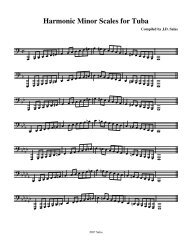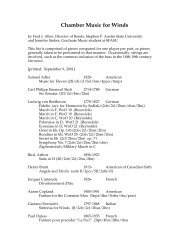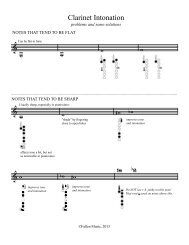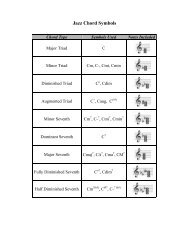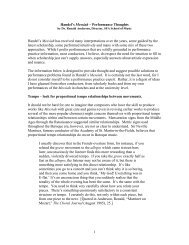Trombone Rep - History of the Trombone - Timeline 1 (EatonMensch ...
Trombone Rep - History of the Trombone - Timeline 1 (EatonMensch ...
Trombone Rep - History of the Trombone - Timeline 1 (EatonMensch ...
Create successful ePaper yourself
Turn your PDF publications into a flip-book with our unique Google optimized e-Paper software.
<strong>History</strong> <strong>of</strong> <strong>the</strong> <strong>Trombone</strong><br />
P. 15<br />
Date Information Citation<br />
mid 1700s<br />
A.D.<br />
ca. 1750s A.D.<br />
1751-1794<br />
A.D.<br />
1756 - 1791<br />
A.D.<br />
1760 A.D.<br />
1760 A.D.<br />
1762 A.D.<br />
1762 A.D.<br />
ca. 1764 A.D.<br />
1765 A.D.<br />
1768 A.D.<br />
<strong>Trombone</strong>s arrive in America with <strong>the</strong> Moravians. Guion p. 125<br />
"…about <strong>the</strong> only universally adopted innovation was <strong>the</strong> flaring bell, a change that took<br />
place in <strong>the</strong> middle <strong>of</strong> <strong>the</strong> eighteenth century."<br />
The Almanach des spectacles lists 10 trombonists and 2 o<strong>the</strong>r musicians who played<br />
trombone, but not as <strong>the</strong>ir main instrument.<br />
"<strong>Trombone</strong>s are similarly used for a few specially solemn or tragic scenes in some <strong>of</strong><br />
Mozart's operas, and in conjunction with choral voices in Haydn's and in Mozart's sacred<br />
works, but <strong>the</strong>y are not employed simply in order to augment <strong>the</strong> volume <strong>of</strong> tone in <strong>the</strong><br />
ordinary tutti."<br />
Francois-Joseph Gossec produced his Mess des morts. <strong>Trombone</strong>s appear in <strong>the</strong> Tuba Mirum<br />
as part <strong>of</strong> an <strong>of</strong>fstage band comprised <strong>of</strong> one clarinet, two trumpets or horns, and three<br />
trombones.<br />
The first "clearly documented use [<strong>of</strong> <strong>the</strong> trombone] in <strong>the</strong> eighteenth century came in 1760."<br />
This came in <strong>the</strong> Tuba mirum <strong>of</strong> Gossec's Messe des morts . While Gossec documents this<br />
himself, <strong>the</strong>re are no trombone parts in <strong>the</strong> printed score.<br />
"…instruments scored for, alto, tenor, and bass, in <strong>the</strong> funereal role in this composer's Messe<br />
des Morts …"<br />
"Gluck's Orfeo ed Euridice appears to be <strong>the</strong> earliest opera in <strong>the</strong> eighteenth century to use<br />
trombones…<strong>the</strong> gloom <strong>of</strong> death hangs heavily whenever <strong>the</strong> trombones are heard."<br />
In Werkstatte der heutigen Kunst Johann Samuel Halle discribes <strong>the</strong> "discant (soprano)<br />
trombone" and <strong>the</strong> use <strong>of</strong> a "handle needed to reach <strong>the</strong> outer positions on <strong>the</strong> bass<br />
trombone…"<br />
The second published mention <strong>of</strong> <strong>the</strong> trombone in France is in <strong>the</strong> Encyclopedie, ou<br />
Dictionnaire raisonne des sciences with music articles by Jean-Jacques Rousseau.<br />
In his Waisenhauskirche Mass , Mozart opens <strong>the</strong> 'Agnus Dei' "with a twelve-measure<br />
trombone trio, unaccompanied except for <strong>the</strong> continuo."<br />
Guion p. 8<br />
Guion p. 178-9<br />
Carse p. 195<br />
Guion p. 169<br />
Guion p. 167, 169-70<br />
Baines p. 242<br />
Guion p. 233-234<br />
Guion p. 64<br />
Guion p. 167<br />
Guion p. 217



![Finale 2008 - [Whole Tone Scales - Tuba.MUS]](https://img.yumpu.com/50937649/1/190x245/finale-2008-whole-tone-scales-tubamus.jpg?quality=85)

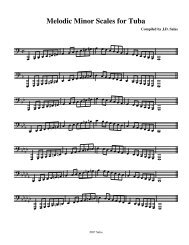
![Finale 2008 - [Chromatic Scales - Tuba.MUS]](https://img.yumpu.com/36500491/1/190x245/finale-2008-chromatic-scales-tubamus.jpg?quality=85)
